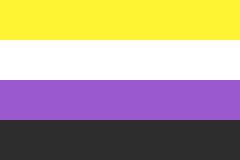 | |
| Classification | Gender identity |
|---|---|
| Abbreviations |
|
| Symbol | |
| Other terms | |
| Synonyms | Genderqueer |
| Associated terms | |
| Part of a series on |
| LGBTQ topics |
|---|
|
|
| Part of a series on |
| Transgender topics |
|---|
|
|
Non-binary[a] and genderqueer are umbrella terms for gender identities that are outside the male/female gender binary.[2][3] Non-binary identities often fall under the transgender umbrella since non-binary people typically identify with a gender that is different from the sex assigned to them at birth,[3] although some non-binary people do not consider themselves transgender.[4][5]
Non-binary people may identify as an intermediate or separate third gender,[6] identify with more than one gender[7][8] or no gender, or have a fluctuating gender identity.[9] Gender identity is separate from sexual or romantic orientation;[10] non-binary people have various sexual orientations.[11]
Being non-binary is also not the same as being intersex. Most intersex people identify as either men or women,[12] although some identify as only non-binary, some identify as non-binary and genderfluid, such as Hida Viloria, while others identify as non-binary men or non-binary women.
Non-binary people as a group vary in their gender expressions, and some may reject gender identity altogether.[13] Some non-binary people receive gender-affirming care to reduce the mental distress caused by gender dysphoria, such as gender-affirming surgery or hormone replacement therapy.[14]
Cite error: There are <ref group=lower-alpha> tags or {{efn}} templates on this page, but the references will not show without a {{reflist|group=lower-alpha}} template or {{notelist}} template (see the help page).
- ^ Bergman, S. Bear; Barker, Meg-John (2017). "Non-binary Activism". In Richards, Christina; Bouman, Walter Pierre; Barker, Meg-John (eds.). Genderqueer and Non-Binary Genders. Critical and Applied Approaches in Sexuality, Gender and Identity. Palgrave Macmillan. p. 43. ISBN 978-1-137-51052-5.
- ^ Cite error: The named reference
richardsetalwas invoked but never defined (see the help page). - ^ a b "Supporting & Caring for Transgender Children" (PDF). Human Rights Campaign. Archived from the original (PDF) on July 24, 2021. Retrieved April 8, 2021.
- ^ "Trans + Gender Identity". The Trevor Project. Archived from the original on July 4, 2018. Retrieved October 11, 2019.
- ^ Cite error: The named reference
Ennis2021was invoked but never defined (see the help page). - ^ Beemyn, Brett Genny (2008). "Genderqueer". glbtq: An Encyclopedia of Gay, Lesbian, Bisexual, Transgender, and Queer Culture. Chicago, Illinois: glbtq, Inc. Archived from the original on April 25, 2012. Retrieved May 3, 2012.[page needed]
- ^ Cite error: The named reference
Bosson-2018was invoked but never defined (see the help page). - ^ Cite error: The named reference
Whytewas invoked but never defined (see the help page). - ^ Winter, Claire Ruth (2010). Understanding Transgender Diversity: A Sensible Explanation of Sexual and Gender Identities. Scotts Valley, California: CreateSpace. ISBN 978-1-4563-1490-3. OCLC 703235508.[page needed]
- ^ "Transgender Glossary of Terms". GLAAD Media Reference Guide. Gay & Lesbian Alliance Against Defamation. Archived from the original on May 30, 2012. Retrieved May 25, 2011.
- ^ Stryker, Susan (2008). Transgender History. Berkeley, California: Seal Press. ISBN 978-1-58005-224-5. OCLC 183914566.[page needed]
- ^ "Understanding Non-Binary People: How to Be Respectful and Supportive". National Center for Transgender Equality. July 9, 2016. Archived from the original on April 6, 2020. Retrieved June 17, 2020.
- ^ Cite error: The named reference
Schornwas invoked but never defined (see the help page). - ^ Hastings, Jennifer (June 17, 2016). "Approach to genderqueer, gender non-conforming, and gender nonbinary people". UCSF Transgender Care. Archived from the original on October 6, 2021. Retrieved October 10, 2021.